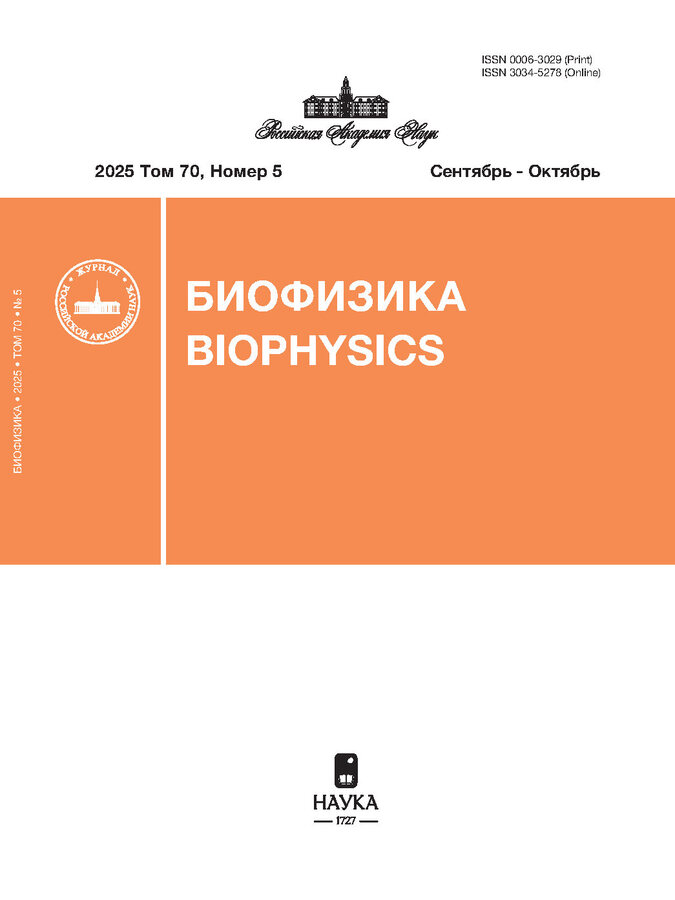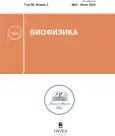ИCCЛЕДОВАНИЕ ВЛИЯНИЯ ФИЗИКО-ХИМИЧЕСКИХ ФАКТОРОВ НА ЧАСТОТУ ТРАНСДУКЦИИ ПЛАЗМИД БАКТЕРИОФАГОМ RB49
- Авторы: Никулина А.Н1, Никулин Н.А1, Зимин А.А1
-
Учреждения:
- Институт биохимии и физиологии микроорганизмов им. Г.К. Скрябина РАН – обособленное подразделение ФИЦ «Пущинский научный центр биологических исследований Российской академии наук»
- Выпуск: Том 69, № 3 (2024)
- Страницы: 544-556
- Раздел: Биофизика клетки
- URL: https://journals.rcsi.science/0006-3029/article/view/262928
- DOI: https://doi.org/10.31857/S0006302924030117
- EDN: https://elibrary.ru/OFBSFW
- ID: 262928
Цитировать
Полный текст
Аннотация
Ключевые слова
Об авторах
А. Н Никулина
Институт биохимии и физиологии микроорганизмов им. Г.К. Скрябина РАН – обособленное подразделение ФИЦ «Пущинский научный центр биологических исследований Российской академии наук»
Email: a.karmanova@ibpm.ru
Пущино, Россия
Н. А Никулин
Институт биохимии и физиологии микроорганизмов им. Г.К. Скрябина РАН – обособленное подразделение ФИЦ «Пущинский научный центр биологических исследований Российской академии наук»Пущино, Россия
А. А Зимин
Институт биохимии и физиологии микроорганизмов им. Г.К. Скрябина РАН – обособленное подразделение ФИЦ «Пущинский научный центр биологических исследований Российской академии наук»Пущино, Россия
Список литературы
- Fernandez L., Gonzalez S., Quiles-Puchalt N., Gutierrez D., Penades J. R., Garcia P., and Rodriguez A. Lysogenization of Staphylococcus aureus RN450 by phages ϕ11 and ϕ80α leads to the activation of the SigB regulon. Sci. Rep., 8 (1), 12662 (2018). doi: 10.1038/s41598-018-31107-z
- Casjens S. Prophages and bacterial genomics: what have we learned so far? Mol. Microbiol., 49, 277–300 (2003). doi: 10.1046/j.1365-2958.2003.03580.x.
- Plunkett G. 3rd, Rose D. J., Durfee T. J., and Blattner F. R. Sequence of Shiga toxin 2 phage 933W from Escherichia coli O157:H7: Shiga toxin as a phage late-gene product. J. Bacteriol., 181 (6), 1767–1778 (1999). doi: 10.1128/JB.181.6.1767-1778.1999
- Howard-Varona C., Vik D. R., Solonenko N. E., Li Y. F., Gazitua M. C., Chittick L., Samiec J. K., Jensen A. E., Anderson P., Howard-Varona A., Kinkhabwala A. A., Abedon S. T., and Sullivan M. B. Fighting Fire with Fire: Phage Potential for the Treatment of E. coli O157 Infection. Antibiotics (Basel, Switzerland), 7 (4), 101 (2018). doi: 10.3390/antibiotics7040101
- Torres-Barcelo C. The disparate effects of bacteriophages on antibiotic-resistant bacteria. Emerg. Microbes Infect., 7 (1), 168 (2018). doi: 10.1038/s41426018-0169-z
- Varga M., Pantu Ček R., Ru Žičkova V., and Doškarˇ J. Molecular characterization of a new efficiently transducing bacteriophage identified in meticillin-resistant Staphylococcus aureus. J. Gen. Virol., 97 (1), 258–268 (2016). doi: 10.1099/jgv.0.000329
- Varga M., Kuntova L., Pantůček R., Mašlaňova I., Růžičkova V., and Doškař J. Efficient transfer of antibiotic resistance plasmids by transduction within methicillinresistant Staphylococcus aureus USA300 clone. FEMS Microbiol. Lett., 332 (2), 146-152 (2012). doi: 10.1111/j.1574-6968.2012.02589.x
- Chiang Y. N., Penades J. R., and Chen J. Genetic transduc-tion by phages and chromosomal islands: The new and noncanonical. PLoS Pathog., 15 (8) (2019). doi: 10.1371/journal.ppat.1007878
- Thierauf A., Perez G., and Maloy A. S. Generalized transduction. Methods Mol. Biol., 501, 267–286 (2009). doi: 10.1007/978-1-60327-164-6_23
- Humphrey S., Fillol-Salom A., Quiles-Puchalt N., Ibarra-Chavez R., Haag A. F., Chen J. and Penades J. R. Bacterial chromosomal mobility via lateral transduction exceeds that of classical mobile genetic elements. Nature Commun., 12 (1), 6509 (2021). doi: 10.1038/s41467-021-26004-5
- Fillol-Salom A., Bacigalupe R., Humphrey S., Chiang Y. N., Chen J., and Penades J. R. Lateral transduction is inherent to the life cycle of the archetypical Salmonella phage P22. Nature Commun., 12 (1), 6510 (2021). doi: 10.1038/s41467-021-26520-4
- Chiang Y. N., Penades J. R., and Chen J. Genetic transduction by phages and chromosomal islands: The new and noncanonical. PLoS Pathog., 15 (8) (2019). doi: 10.1371/journal.ppat.1007878
- Tanyashin V. I., Zimin A. A., Shlyapnikov M. G., and Boronin A. M. Transduction of Plasmid Antibiotic Resistance Determinants with PseudoT-Even Bacteriophages. Rus. J. Genet., 39, 761–772 (2003). doi: 10.1023/A:1024748903232
- Никулина А. Н., Зимин А. А. и Кощаев А. Г. Изучение влияния температуры на трансдукционную способность и литическую активность бактериофагов RB43 и RB49. Труды Кубанского гос. аграрного ун-та, 101, 283–292 (2022). doi: 10.21515/19991703-101-283-292
- Simmonds P., Adriaenssens E. M., Zerbini F. M., Abrescia N. G. A., Aiewsakun P., Alfenas-Zerbini P., Bao Y., Barylski J., Drosten Ch., Duffy S., DuprexW. P., Dutilh B. E., Elena S. F., Garcia M. L., Junglen S., Katzourakis A., Koonin E. V., Krupovic M., Kuhn J. H., Lambert A. J., Lefkowitz E. J., Łobocka M., Lood C., Mahony J., MeierKolthoff J. P., Mushegian A. R., Oksanen H. M., Poranen Minna M., Reyes-Munoz A., Robertson D. L., Roux S., Rubino L., Sabanadzovic S., Siddell S., SkernT., Smith D. B., Sullivan M. B., Suzuki N., Turner D., Van Doorslaer K., Vandamme A.-M., Varsani A., and Vasilakis N. Four principles to establish a universal virus taxonomy. PLoS Biol., 21 (2), e3001922 (2023). doi: 10.1371/journal.pbio.3001922
- Monod C., Repoila F., Kutateladze M., Tetart F., and Krisch, H. M. The genome of the pseudo T-even bacteriophages, a diverse group that resembles T4. J. Mol. Biol., 267 (2), 237–249 (1997). doi: 10.1006/jmbi.1996.0867
- Gao S., Zhang L., and Rao V. B. Exclusion of small terminase mediated DNA threading models for genome packaging in bacteriophage T4. Nucl. Acids Res., 44 (9), 4425–4439 (2016). doi: 10.1093/nar/gkw184
- Gao S. and Rao V. B. Specificity of interactions among the DNA-packaging machine components of T4-related bacteriophages. J. Biol. Chem., 286 (5), 3944–3956 (2011). doi: 10.1074/jbc.M110.196907
- Rao V.B., Fokine A., Fang Q., and Shao Q. Bacteriophage T4 head: structure, assembly, and genome packaging. Viruses, 15 (2), 527 (2023). doi: 10.3390/v15020527
- Takahashi H. and Saito H. Mechanism of pBR322 transduction mediated by cytosine-substituting T4 bacteriophage. Mol. Gen. Genet., 186 (4), 497–500 (1982). doi: 10.1007/BF00337955
- Wilson G. G., Young K. Y., Edlin G. J., and KonigsbergW. High-frequency generalised transduction by bacteriophage T4. Nature, 280 (5717), 80–82 (1979). doi: 10.1038/280080a0
- Kreuzer K. N. and Alberts B. M. Characterization of a defective phage system for the analysis of bacteriophage T4 DNA replication origins. J. Mol. Biol., 188 (2), 185–198 (1986). doi: 10.1016/0022-2836(86)90303-7
- Маниатис Т., Фрич Э. и Сэмбрук Дж. Молекулярное клонирование (Мир, М., 1984).
- Jofre J. and Muniesa M. Bacteriophage Isolation and Characterization: Phages of Escherichia coli. Methods Mol. Biol., 2075, 61–79 (2020). doi: 10.1007/978-14939-9877-7_4
- Majewska J., Miernikiewicz P., Szymczak A., Kaźmierczak Z., Goszczyński T. M., Owczarek B., Rybicka I., Ciekot J., and Dąbrowska K. Evolution of the T4 phage virion is driven by selection pressure from nonbacterial factors. Microbiol. Spectrum, 11 (5), e00115-23 (2023). doi: 10.1128/spectrum.00115-23
- Kejnovsky E., Nejedly K., and Kypr J. Factors influencing resistance of UV-irradiated DNA to the restriction endonuclease cleavage. Int. J. Biol. Macromol., 34 (3), 213–222 (2004). doi: 10.1016/j.ijbiomac.2004.04.004
- Nelson K. L., Boehm A. B., Davies-Colley R. J., Dodd M. C., Kohn T., Linden K. G., Liu Yu., Maraccini P. A., McNeill K., Mitch W. A., Nguyen Th. H., Parker K. M., Rodriguez R. A., Sassoubre L. M., Silverman A. I., Wigginton K. R., and Zepp R. G. Sunlightmediated inactivation of health-relevant microorganisms in water: a review of mechanisms and modeling approaches. Environ. Sci. Process Impacts, 20 (8), 1089–1122 (2018). doi: 10.1039/c8em00047f
Дополнительные файлы










